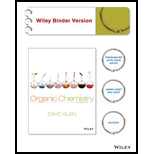
(a)
Interpretation: The protic and aprotic nature for the given solvents should be classified.
Concept Introduction:
Protic solvent: solvents that contains
Aprotic solvent: they do not contain
Electronegativity: it is the ability of atom to attract a lone pair of electrons towards itself in a substrate. Electronegativity property follows the trend that it increases across the periods and decreases down the column in the periodic table.
(b)
Interpretation: The protic and aprotic nature for the given solvents should be classified.
Concept Introduction:
Protic solvent: solvents that contains
Aprotic solvent: they do not contain
Electronegativity: it is the ability of atom to attract a lone pair of electrons towards itself in a substrate. Electronegativity property follows the trend that it increases across the periods and decreases down the column in the periodic table.
(c)
Interpretation: The protic and aprotic nature for the given solvents should be classified.
Concept Introduction:
Protic solvent: solvents that contains
Aprotic solvent: they do not contain
Electronegativity: it is the ability of atom to attract a lone pair of electrons towards itself in a substrate. Electronegativity property follows the trend that it increases across the periods and decreases down the column in the periodic table.
(d)
Interpretation: The protic and aprotic nature for the given solvents should be classified.
Concept Introduction:
Protic solvent: solvents that contains
Aprotic solvent: they do not contain
Electronegativity: it is the ability of atom to attract a lone pair of electrons towards itself in a substrate. Electronegativity property follows the trend that it increases across the periods and decreases down the column in the periodic table.
(e)
Interpretation: The protic and aprotic nature for the given solvents should be classified.
Concept Introduction:
Protic solvent: solvents that contains
Aprotic solvent: they do not contain
Electronegativity: it is the ability of atom to attract a lone pair of electrons towards itself in a substrate. Electronegativity property follows the trend that it increases across the periods and decreases down the column in the periodic table.
Want to see the full answer?
Check out a sample textbook solution
Chapter 7 Solutions
Organic Chemistry, Binder Ready Version
- Provide steps and explanation please.arrow_forwardDraw a structural formula for the major product of the acid-base reaction shown. H 0 N + HCI (1 mole) CH3 N' (1 mole) CH3 You do not have to consider stereochemistry. ● • Do not include counter-ions, e.g., Na+, I, in your answer. . In those cases in which there are two reactants, draw only the product from 989 CH3 344 ? [Farrow_forwardQuestion 15 What is the major neutral organic product for the following sequence? 1. POCI₂ pyridine ? 2. OsO4 OH 3. NaHSO Major Organic Product ✓ OH OH 'OH OH 'OH 'CIarrow_forward
- Could you please solve the first problem in this way and present it similarly but color-coded or step by step so I can understand it better? Thank you!arrow_forwardCould you please solve the first problem in this way and present it similarly but color-coded or step by step so I can understand it better? Thank you!arrow_forwardCould you please solve the first problem in this way and present it similarly but (color-coded) and step by step so I can understand it better? Thank you! I want to see what they are doingarrow_forward
- Can you please help mne with this problem. Im a visual person, so can you redraw it, potentislly color code and then as well explain it. I know im given CO2 use that to explain to me, as well as maybe give me a second example just to clarify even more with drawings (visuals) and explanations.arrow_forwardPart 1. Aqueous 0.010M AgNO 3 is slowly added to a 50-ml solution containing both carbonate [co32-] = 0.105 M and sulfate [soy] = 0.164 M anions. Given the ksp of Ag2CO3 and Ag₂ soy below. Answer the ff: Ag₂ CO3 = 2 Ag+ caq) + co} (aq) ksp = 8.10 × 10-12 Ag₂SO4 = 2Ag+(aq) + soy² (aq) ksp = 1.20 × 10-5 a) which salt will precipitate first? (b) What % of the first anion precipitated will remain in the solution. by the time the second anion starts to precipitate? (c) What is the effect of low pH (more acidic) condition on the separate of the carbonate and sulfate anions via silver precipitation? What is the effect of high pH (more basic)? Provide appropriate explanation per answerarrow_forwardPart 4. Butanoic acid (ka= 1.52× 10-5) has a partition coefficient of 3.0 (favors benzene) when distributed bet. water and benzene. What is the formal concentration of butanoic acid in each phase when 0.10M aqueous butanoic acid is extracted w❘ 25 mL of benzene 100 mL of a) at pit 5.00 b) at pH 9.00arrow_forward
 ChemistryChemistryISBN:9781305957404Author:Steven S. Zumdahl, Susan A. Zumdahl, Donald J. DeCostePublisher:Cengage Learning
ChemistryChemistryISBN:9781305957404Author:Steven S. Zumdahl, Susan A. Zumdahl, Donald J. DeCostePublisher:Cengage Learning ChemistryChemistryISBN:9781259911156Author:Raymond Chang Dr., Jason Overby ProfessorPublisher:McGraw-Hill Education
ChemistryChemistryISBN:9781259911156Author:Raymond Chang Dr., Jason Overby ProfessorPublisher:McGraw-Hill Education Principles of Instrumental AnalysisChemistryISBN:9781305577213Author:Douglas A. Skoog, F. James Holler, Stanley R. CrouchPublisher:Cengage Learning
Principles of Instrumental AnalysisChemistryISBN:9781305577213Author:Douglas A. Skoog, F. James Holler, Stanley R. CrouchPublisher:Cengage Learning Organic ChemistryChemistryISBN:9780078021558Author:Janice Gorzynski Smith Dr.Publisher:McGraw-Hill Education
Organic ChemistryChemistryISBN:9780078021558Author:Janice Gorzynski Smith Dr.Publisher:McGraw-Hill Education Chemistry: Principles and ReactionsChemistryISBN:9781305079373Author:William L. Masterton, Cecile N. HurleyPublisher:Cengage Learning
Chemistry: Principles and ReactionsChemistryISBN:9781305079373Author:William L. Masterton, Cecile N. HurleyPublisher:Cengage Learning Elementary Principles of Chemical Processes, Bind...ChemistryISBN:9781118431221Author:Richard M. Felder, Ronald W. Rousseau, Lisa G. BullardPublisher:WILEY
Elementary Principles of Chemical Processes, Bind...ChemistryISBN:9781118431221Author:Richard M. Felder, Ronald W. Rousseau, Lisa G. BullardPublisher:WILEY





